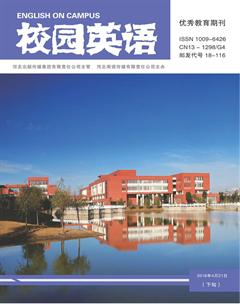AestheticValueofTrademarkTranslation
陈佳
【Abstract】Trademarks and trademark, as a part of language, are unavoidably influenced and restricted by the cultures of various countries and nationalities. Through trademark, we can get abundant implications of social history and culture. Language is the most important tool of information transmission. It can not only convey sentence and semantic information, but also carry additional contents of society and culture. In order to meet the increasingly competitive demands of market, in addition to express detailed information of commodity, the differences of aesthetic psychology between diverse cultural customers shall be taken into consideration when naming modern brand names.
【Key Words】trademark; brand; aesthetic theory; translation
1. Descriptions of Trademark
Trademark translation is a special cross-cultural activity. It requires higher standards than other ordinary translation. In the process of translation,we should not only consider being equivalent and faithful to the original text, but also need to innovate bravely, and think comprehensively from the aspects of cultural habits, trademark features and group psychology to translate a brand name which could express inner meaning and take customers psychological sense into consideration.
2. Descriptions of Trademark Translation
“Trademark translation is a cross-cultural communication activity. Every trademark implies its cultural connotation. While translating it, we shall pay attention to the cultural differences and have the version comply with consumers cultural psychology, language rules and the regional culture.”
The method can be embodied in the following examples: theme park Disney, dust collector Hoover, cosmetics ponds, chemical company Du Pont, automobile Benz and Ford, clothes Pierre Cardin, food Nestlés.
The method can be embodied in the following examples: mobile phone Nokia is a small town in north Finland. Wrist watch Longines is a small village close to Switzerland. Champagne is named after place of origin in France. Avon is named according to Stratford-on-Avon —— a river where Shakespeare born. Record company Columbia is a place located in Washington, District of Columbia.
3. Aesthetic Principles of Trademark Translation
Aesthetic pronunciation refers to pronunciation loud in sound, clear in rhythm, musical in hearing and arising appreciation in mind. Once enjoyment occurs inside peoples mind, expectation follows. This kind of psycho is popular in trademark translation to great extent. Rhyme, tone, characteristics-oriented, syllable number, etc., are important factors.
4. Principles of Trademark Translation
Looking at the form of language, the construction of trademark is quite simple and easy to understand, but it has the function of product positioning and promotion, the characteristics of readable and melodious in language, pretty and appealing in packing design.
Trademark translation requires not only professional knowledge of translation, but also the ability to appreciate beauty, to feel the charm of trade in packing design. For the writing style of foreign character reflects not only the concept and enterprise and the function of product, but also aesthetic features in different nationalities.
5. Rhetoric Methods Used in English Trademarks
For example, pure water Robust, whose Chinese version is Le Bai Shi, means be happy all the life long. Another example, insurance company Longevity, whose Chinese version is Chang Shou, means that you will live an old age if you buy their insurance.
Exaggeration is used to emphasize on fact and also overstate the fact, then give a deep impression to customers. Therefore, abundant imagination can be stimulated. There are some examples, Safeguard, Life-saver, Magic Market.
6. conclusion
Trademark, as the intangible assets of enterprises, is a commodity-sign made up of character and implication, many aesthetic features have been implied in tone, form and meaning. The differences of aesthetic consciousness between the east and the west shall be taken into consideration when translating trademarks so as to achieve same aesthetic effect with the original trademark, therefore, a favorable image of the brand will be built in international market.
References:
[1]Deal,Terrence & Kennedy,Allan.The New Corporate Cultures[M].London:TEXERE Publishing Limited,1999.
[2]Hatim,Basil & Ian Mason.Discourse and The Translator[M].Shanghai Foreign Language Education Press,2001.
[3]刘宓庆.刘宓庆翻译散论[M].北京:中国对外翻译出版社,2006.
[4]毛荣贵.新世纪大学汉英翻译教程[M].上海:上海交通大学出版社,2002.

